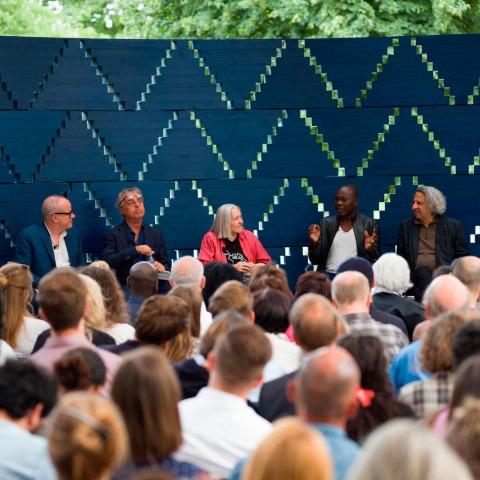Francis Kéré in conversation with Stefano Boeri (Stefano Boeri Architetti), Mohsen Mostafavi (Dean, Harvard Graduate School of Design), Hans Ulrich Obrist (Artistic Director, Serpentine Galleries), and Saskia Sassen (Professor, Columbia University).
Diébédo Francis Kéré talks about his 2017 Pavilion design, his work in Burkina Faso and his German influences.
Inspired by the tree that serves as a central meeting point for life in his home town of Gando, Burkina Faso, Francis Kéré design is a responsive Pavilion that seeks to connect its visitors to nature – and each other. An expansive roof, supported by a central steel framework, mimics a tree’s canopy, allowing air to circulate freely while offering shelter against London rain and summer heat.
&
Francis Kéré in conversation with Stefano Boeri (Stefano Boeri Architetti), Mohsen Mostafavi (Dean, Harvard Graduate School of Design), Hans Ulrich Obrist (Artistic Director, Serpentine Galleries), and Saskia Sassen (Professor, Columbia University).
More information
Published on:
August 15, 2017
Cite:
"Francis Kéré in conversation, Serpentine Pavilion 2017" METALOCUS.
Accessed
<https://www.metalocus.es/en/news/francis-kere-conversation-serpentine-pavilion-2017>
ISSN 1139-6415
Loading content ...
Loading content ...
Loading content ...
Loading content ...
Loading content ...
Loading content ...
Loading content ...
Loading content ...
Loading content ...
Loading content ...
Loading content ...
Loading content ...
Loading content ...
Loading content ...
Loading content ...
Loading content ...
Loading content ...
Loading content ...
Loading content ...
Loading content ...
Loading content ...
Loading content ...
Loading content ...
Loading content ...
Loading content ...
Loading content ...
Loading content ...
Loading content ...
Loading content ...
Loading content ...
Loading content ...
Loading content ...
Loading content ...
Loading content ...
Loading content ...
Loading content ...
Loading content ...
Loading content ...
Loading content ...
Loading content ...
Loading content ...
Loading content ...
Loading content ...
Loading content ...
Loading content ...
Loading content ...
Loading content ...
Loading content ...
Loading content ...
Loading content ...
Loading content ...
Loading content ...
Loading content ...
Loading content ...







































